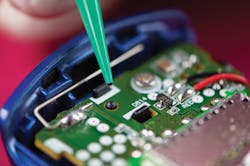EP5G-80
Master Bond EP5G-80 is a one component, NASA low outgassing rated epoxy, with a moderate temperature cure requirement of 80°C for 4 hours. This graphite filled compound is not premixed and frozen and has an unlimited working life at room temperature. It offers electrical conductivity with a volume resistivity of 5-15 ohm-cm and a thermal conductivity of 2.88-3.46 W/(m•K) at room temperature.
“EP5G-80 is a specialty non-metallic system designed for heat sensitive electronic applications where high levels of conductivity are desired. Its key feature is that it does not need elevated heat to fully cure,” says Rohit Ramnath, Senior Product Engineer. “Unlike other graphite filled adhesives, EP5G-80 is a smooth thixotropic paste and can be easily dispensed manually or using automated systems.”
For a conductive system, EP5G-80 provides an especially high Tg of around 130°-140°C, and a tensile modulus that exceeds 1,000,000 psi at room temperature. It is serviceable over the temperature range of -50°C to +175°C and has a low coefficient of thermal expansion. Suitable for bonding, sealing and coating, EP5G-80 adheres well to a variety of substrates such as metals, composites, ceramics and many plastics. This formulation features a good lubricity and can be employed for static dissipation and EMI/RFI shielding applications. It is black in color and RoHS compliant. Packaging is available in syringes, jar and pint containers.
